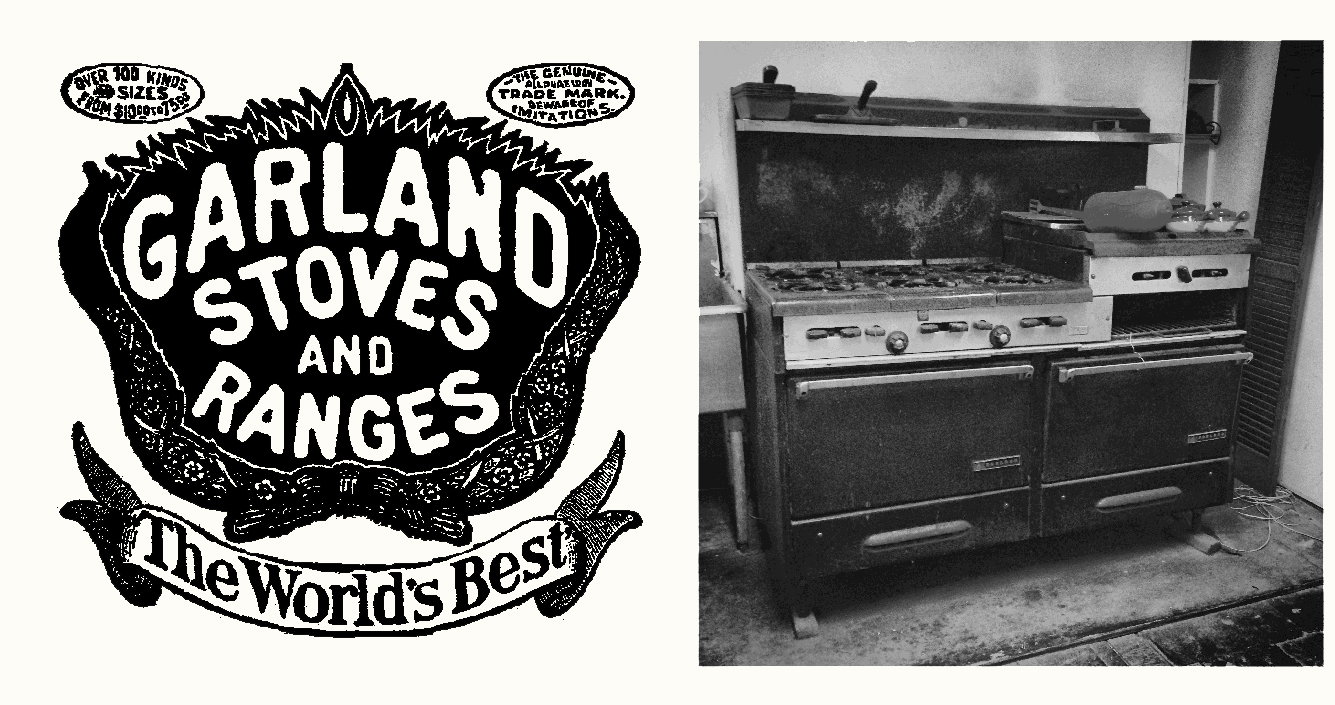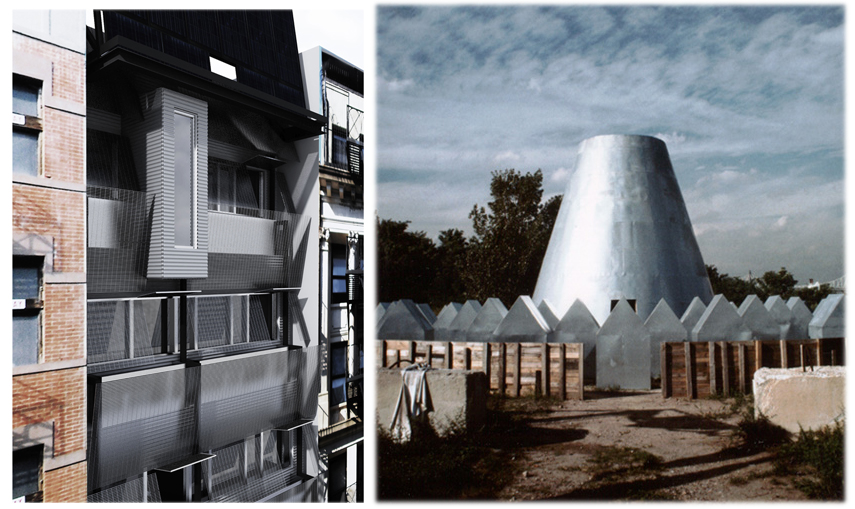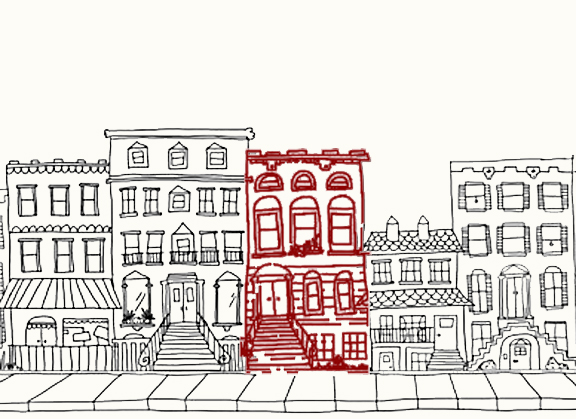158 Clifton Place, Brooklyn c. 1840 – NYC Municipal Archives
 The scattered belongings left in the house include the expected – remnant building supplies, old books, a few lights, a mattress, broken electronics…and a half ton commercial stove – a surprise encounter in the basement kitchen. As it happened, the owners mom ran a restaurant in the neighborhood years ago and the stove was brought back when it closed. Even minimally maintained, it’s a culinary workhorse. It may have eBay value or resale to a restaurant equipment dealer, at least for parts – if we can figure how to get it out. When it was brought in thirty years ago, the stoop was gone (the original was wood, like the facade), and it squeezed through the front without having to angle through the current vestibule. The other articles left within the house read like a list of yard sale leftovers, though some of the lot hopes to get a closer look.
The scattered belongings left in the house include the expected – remnant building supplies, old books, a few lights, a mattress, broken electronics…and a half ton commercial stove – a surprise encounter in the basement kitchen. As it happened, the owners mom ran a restaurant in the neighborhood years ago and the stove was brought back when it closed. Even minimally maintained, it’s a culinary workhorse. It may have eBay value or resale to a restaurant equipment dealer, at least for parts – if we can figure how to get it out. When it was brought in thirty years ago, the stoop was gone (the original was wood, like the facade), and it squeezed through the front without having to angle through the current vestibule. The other articles left within the house read like a list of yard sale leftovers, though some of the lot hopes to get a closer look.
Squib History: The Garland Stove was introduced in Detroit, back in 1860‘s Civil War era by brothers Jeremiah and James Dwyer. They started out with potbellied models for heating, and soon added cooking stoves. The industry was helped along by the shipping industry on the Great Lakes and Iron ore from upper Michigan, and made Detroit the “Potbelly Stove Capital”. And the Garland Stove became a symbol of Detroit’s manufacturing strength in the late nineteenth century – building the road for the automobile industry that would follow.
 THE ARCHITECT was a hard decision. Even within the current short list of Passive House Certified professionals, NYC offers a great range of individuals and firms, each with strong and unique qualifications, track records, and personal commitments to sustainability. In the end, we went with Paul Castrucci, Architect.
THE ARCHITECT was a hard decision. Even within the current short list of Passive House Certified professionals, NYC offers a great range of individuals and firms, each with strong and unique qualifications, track records, and personal commitments to sustainability. In the end, we went with Paul Castrucci, Architect.
Paul A. Castrucci Architect has a long track record in sustainable design. Established over 20 years ago, the firm often works towards drastically reduced energy use, with advanced energy analysis and ongoing research – alongside design excellence.
The firm is located on Manhattan’s Lower East Side. Over the past decades, Mr. Castrucci has been actively involved in the community and its development, including the current restoration of ABC No Rio. He has designed and renovated sites throughout the Bronx, Brooklyn and Manhattan, many specifically for the homeless and those with low incomes. Paul Castrucci is also an accomplished curator, sculptor and blacksmith. He directed the Lower East Side art spaces A & P and Bullet.
 Sawkill will gut renovate an old row house in Brooklyn. The chronicle begins here. It’s a daunting task for first time homeowners, but offers the chance to design and retro-fit a high efficiency home. At the outset, the scope still looks like the back side of a blueprint, due to hidden and patchwork mechanicals, potential structural surprises and plain inexperience. The Passive House certification may not be within budget reach, but the house has retro-fit friendly features that make it a good prospect still – that’s the current assessment of an energy consultant. At least three factors contribute 1. A gut renovation can not be avoided in the aftermath of a half century of patchwork repairs, and this opens the interior for a better retro-fit. 2. Relative to the heavy masonry walls of a brownstone, a wooden house allows access to the front of the building, easier for adding insulation. 3. The thin Federal style brick walls create a kind of single lane thermal bridge to limit heat loss. Added to a south solar rear, bad bones look good – at least for the energy retro-fit.
Sawkill will gut renovate an old row house in Brooklyn. The chronicle begins here. It’s a daunting task for first time homeowners, but offers the chance to design and retro-fit a high efficiency home. At the outset, the scope still looks like the back side of a blueprint, due to hidden and patchwork mechanicals, potential structural surprises and plain inexperience. The Passive House certification may not be within budget reach, but the house has retro-fit friendly features that make it a good prospect still – that’s the current assessment of an energy consultant. At least three factors contribute 1. A gut renovation can not be avoided in the aftermath of a half century of patchwork repairs, and this opens the interior for a better retro-fit. 2. Relative to the heavy masonry walls of a brownstone, a wooden house allows access to the front of the building, easier for adding insulation. 3. The thin Federal style brick walls create a kind of single lane thermal bridge to limit heat loss. Added to a south solar rear, bad bones look good – at least for the energy retro-fit.
Passive House is more than off the ground in New York, with resources and specialized materials quickly developing, like a young tree sapling passing a potentially stagnant growth stage. It’s a deceptively simple and elegant approach – amounting to super insulating the house and ventilating it’s hermetic envelope. Sawkill recently supplied woods for Passive House projects in Prospect Heights and Clinton Hill; both encouraging Brownstone studies – though not yet inhabited. But without a longer track record, PH can still seem like an early phase science experiment. Except that it’s a growing niche in Europe: over 25,000 PH structures since the late 80’s.
The posts here will ramble through the promises and pitfalls of energy efficiency, salvaging and re-manufacturing woods, the nuts and bolts of renovation work, house history, related currents. If birds or running water are heard, we’ve probably stepped into the backyard to take a rest.

COPYRIGHT © 2023 SAWKILL NYC. ALL RIGHTS RESERVED. WEBSITE BY B. MARTIN STUDIO.